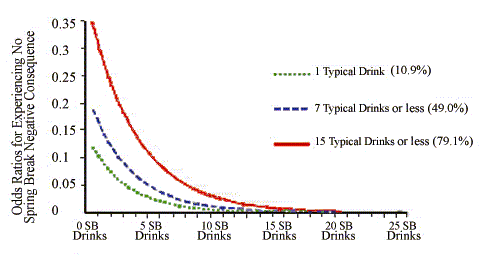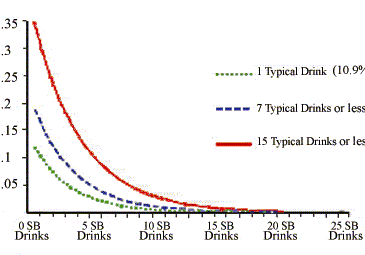Research indicates that special events (e.g., 21st birthdays, holidays, etc.) are times of increased alcohol consumption and alcohol-related negative consequences for college students (Lewis, Lindgren, Fossos, Neighbors, & Oster-Aaland, 2009; Perkins, 2002). This week’s DRAM reviews a study that examined the association between alcohol intake and negative consequences among freshman college students during Spring Break (SB) (Lee, Lewis, & Neighbors, 2009).
Methods
- Participants (n=726) were freshman college students who participated in a longitudinal web-based survey regarding alcohol intake; these students qualified as heavy drinkers (i.e., one or more incidents of heavy drinking in the past month; 4+ drinks for women, 5+ drinks for men) at baseline (i.e., first quarter of freshman year).
- Measures, assessed one week after SB, included:
- Typical weekly alcohol intake – average number drinks/week during the past three months using the Daily Drinking Questionnaire (Collins, Parks, & Marlatt, 1985).
- SB alcohol intake – total number of SB drinks using a retrospective Timeline Feedback report (Sobell & Sobell, 2002).
- SB alcohol-related negative consequences – adapted from the Rutger’s Alcohol Problem Index (White, 1989) and the Young Adult Alcohol Problems Screening Test (Hurlbut & Sher, 1992).
Results
- 70% of participants drank during SB; participants consumed an average of 15.26 drinks across the 10 days of SB.
- 36% of participants reported experiencing at least one SB alcohol-related negative consequence; drinking during SB was positively associated with negative consequences.
- Participants who were typically light drinkers at the time of SB were more likely to report negative consequences if they drank during SB than typically heavy drinkers (see Figure).

Figure. Odds ratios for reporting zero negative consequences during SB by typical drinking groups (adapted from Lee et al., 2009). Click image to enlarge.
Note: The Y axis of the figure is the odds-ratio of experiencing no negative consequences due to drinking during SB. The plot shows the decreasing likelihood of no negative consequences as the number of SB drinks increases (X axis) for the three groups defined by recent typical amount of drinking.) Consequences included – 1. Had a hangover the morning after you had been drinking; 2. Felt sick to your stomach or threw up after drinking; 3. Passed out or fainted suddenly; 4. Had a fight, argument, or bad feelings with a friend; 5. Received an injury as a result of drinking; 6. Got into fights, acted bad, or did mean things; 7. Got into sexual situations that you later regretted; and 8. Had a fight, argument or bad feelings with a family member.
Limitations
- All alcohol consumption information is retrospective self report.
- Inclusion criteria included heavy drinking at baseline. Thus, even “light” drinkers at the six month follow-up had qualified as heavy drinkers in the first quarter assessment, and results should be interpreted accordingly.
- The study analyzed number of consequences, not type of consequence, despite the diversity and differing prevalence of consequences (e.g., hangover vs. injury).
Discussion
The results suggest that drinking during SB is associated with negative consequences for all levels of drinking, but is particularly problematic for students who have been light drinkers in the months surrounding SB. Since all of the participants in the study were initially classified as heavy drinkers in the first quarter of their freshman year, it is unclear whether these results generalize to all light drinkers or specifically to students who have recently limited their drinking. More research is needed to test these findings in a more diverse range of students. If confirmed, the results might inform intervention efforts for specific events associated with higher alcohol intake, suggesting a focus on students who typically drink infrequently.
— Tasha Chandler
What do you think? Please use the comment link below to provide feedback on this article.
References
Collins, R. L., Parks, G. A., & Marlatt, G. A. (1985). Social determinants of alcohol consumption: The effects of social interaction and model status on the self-administration of alcohol. Journal of Consulting Clinical Psychology, 53(2), 189-200.
Hurlbut, S. C., & Sher, K. J. (1992). Assessing alcohol problems in college students. Journal of American College Health, 41(2), 49-58.
Lee, C. M., Lewis, M. A., & Neighbors, C. (2009). Preliminary examination of spring break alcohol use and related consequences. Psychology of Addictive Behaviors, 23(4), 689-694.
Lewis, M. A., Lindgren, K. P., Fossos, N., Neighbors, C., & Oster-Aaland, L. (2009). Examining the relationship between typical drinking behavior and 21st birthday drinking behavior among college students: Implications for event-specific prevention. Addiction, 104(5), 760-767.
Perkins, H. W. (2002). Surveying the damage: A review of research on consequences of alcohol misuse in college populations. Journal of Studies on Alcohol – Supplement(14), 91-100.
Sobell, L. C., & Sobell, M. B. (2002). Alcohol Timeline Followback (TLFB). In A. P. Association (Ed.), Handbook of psychiatric measures (pp. 477-479). Washington, DC: American Psychiatric Association.
White, H. R., & Labouvie, E.W. (1989). Towards the assessment of adolescent problem drinking. Journal of Studies on Alcohol, 50(1), 30-37.




